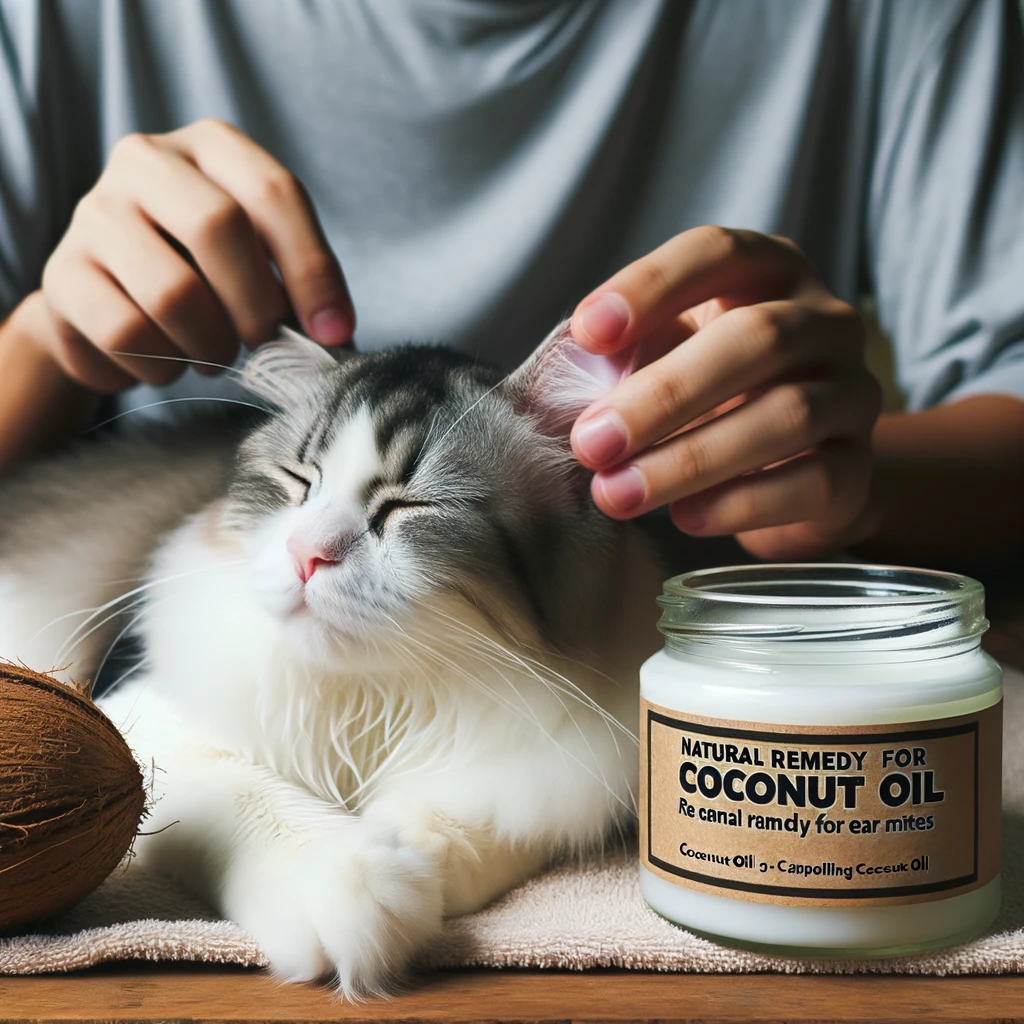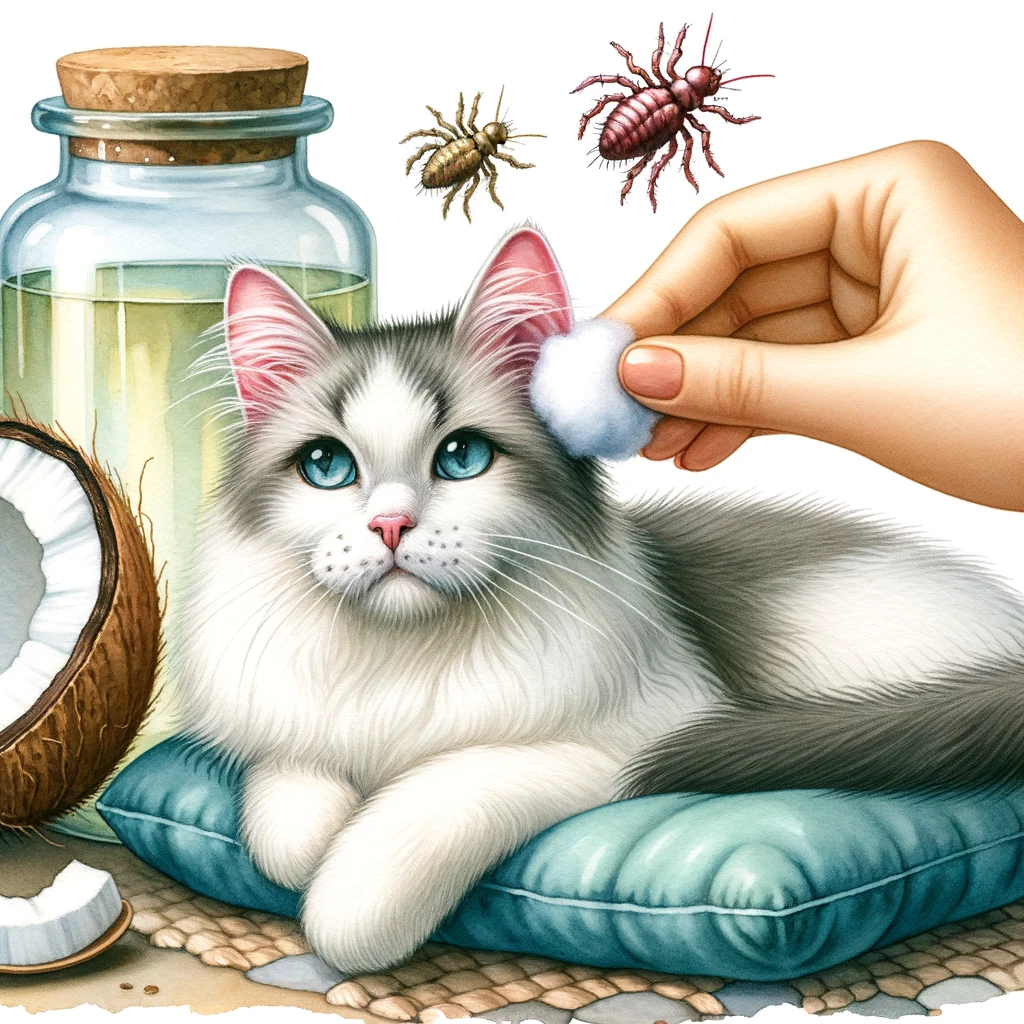For many cat owners, the sight of their feline friend incessantly scratching their ears is a cause for concern. One common culprit behind this behavior is an infestation of ear mites. But what exactly are these pesky parasites?
What are Ear Mites?
Ear mites, scientifically known as Otodectes cynotis, are tiny, spider-like parasitic mites that dwell in the ears of cats, dogs, and even ferrets. They feed on the ear wax and oils, leading to inflammation and discomfort.

Signs and Symptoms
If your cat has ear mites, you might notice some of these symptoms:
- Intense Scratching: Cats with ear mites will often scratch their ears vigorously.
- Dark, Coffee-Like Debris: The presence of a dark, grainy discharge resembling coffee grounds in the ear canal is a telltale sign.
- Odor: An unusual strong and foul smell may emanate from the infected ears.
- Redness and Swelling: The cat’s ears might appear inflamed with signs of redness and swelling.
The Need for Prompt Treatment
Left untreated, an ear mite infestation can lead to more severe complications, including skin infections, painful ear hematomas caused by excessive scratching, and even potential hearing loss.
Coconut Oil: Nature’s Remedy for Ear Mites
For centuries, coconut oil has been hailed for its myriad health benefits for both humans and animals. Its use in treating various ailments is well-documented, but can it truly be effective against ear mites in cats?
The Healing Components of Coconut Oil
Coconut oil is primarily composed of saturated fats, with medium-chain triglycerides (MCTs) being its primary constituent. One of these MCTs, lauric acid, is particularly noteworthy. When coconut oil is applied, lauric acid transforms into monolaurin, a compound known for its potent antimicrobial properties.
Why Consider Coconut Oil?
- Natural Antimicrobial Properties: Lauric acid’s ability to combat bacteria and fungi gives coconut oil an edge in addressing infections that may arise due to ear mites.
- Soothing Effect: Coconut oil can provide relief from itching and inflammation, making it a comforting remedy for cats suffering from ear mite infestations.
- Safe and Chemical-Free: For cat owners wary of using chemicals or artificial products, coconut oil offers a natural and typically side-effect-free alternative.
Limitations
While coconut oil has its merits, it’s essential to acknowledge that it might not be a one-size-fits-all solution. Some cats might have allergies, or the severity of the infestation may require more potent treatments. It’s always a good idea to test a small amount of coconut oil first to check for any adverse reactions.
Applying Coconut Oil: A Step-by-Step Guide
Using coconut oil for ear mites in cats is a straightforward process, but there are certain steps and precautions one should be aware of to ensure effective and safe treatment.
Preparation
Before diving into the application, ensure you have:
- High-Quality Coconut Oil: Opt for virgin or cold-pressed coconut oil. These types haven’t been refined and retain the most beneficial properties.
- A Clean Cloth or Cotton Ball: For application and cleaning.
- A Towel: In case your cat gets squirmy, it’s useful to wrap them gently but firmly.
Application Process
- Warm the Oil: Coconut oil is solid at room temperature. Warm a small amount by placing it in a container and immersing it in warm water. Ensure it’s lukewarm, not hot, to prevent any discomfort to your cat.
- Clean the Ear: Using a clean cloth or cotton ball, gently wipe away any debris or discharge from the cat’s ear. This preps the ear for treatment.
- Apply Coconut Oil: Dip a fresh cotton ball into the lukewarm coconut oil, ensuring it’s saturated but not dripping. Gently rub the cotton ball in the cat’s ear, making sure to get into all the crevices but not too deep as to hurt your cat.
- Massage Gently: After application, massage the base of your cat’s ear gently. This helps in spreading the oil deeper into the ear canal where mites might reside.
Frequency of Application
For optimal results, consider applying coconut oil once a day for at least a week. However, monitor your cat’s symptoms and adjust accordingly. If there’s a noticeable improvement, you might reduce the frequency.
Precautions
- Monitor for Allergies: Though coconut oil is generally safe, observe your cat after the first application for any signs of allergies or discomfort.
- Avoid Overuse: Over-saturation can lead to other complications. It’s essential to strike a balance.
- Seek Vet’s Opinion: If in doubt, always consult with your veterinarian before starting any home remedy.
Coconut Oil vs. Other Ear Mite Treatments
While coconut oil has emerged as a natural alternative for treating ear mites in cats, it’s vital to compare it with other available treatments to make an informed decision.
Traditional Chemical Treatments
- Prescription Ear Drops: Veterinarians often prescribe medicated ear drops that contain insecticides to kill ear mites. These are typically fast-acting and effective.
- Over-the-Counter Treatments: There are various OTC treatments available, some of which might contain chemicals while others boast natural ingredients.
Advantages of Coconut Oil
- Natural and Chemical-Free: Coconut oil offers a natural remedy without the potential side effects of chemicals.
- Cost-Effective: In comparison to some medicated treatments, coconut oil is relatively inexpensive and widely available.
- Multipurpose Use: Beyond ear mite treatment, coconut oil can be used for various other ailments in cats, like dry skin, minor cuts, or as a dietary supplement.
Limitations of Coconut Oil
- Might Require Longer Treatment Duration: While chemical treatments are often faster, coconut oil might require a more prolonged application to see results.
- Not Suitable for Severe Infestations: In cases of intense infestations or complications like infections, a stronger medicated approach may be necessary.
Considerations for Choosing a Treatment
- Severity of the Infestation: For mild cases, coconut oil can be an excellent first line of defense. However, severe infestations might require a combination of treatments.
- Cat’s Health and Age: Kittens, elderly cats, or those with compromised immune systems might react differently to treatments.
- Owner’s Preference: Some cat owners prefer natural solutions, while others might opt for quicker, medicated routes.
Exploring Alternative Natural Remedies for Ear Mites
While coconut oil stands out for its versatile healing properties, it’s not the only natural remedy cat owners turn to in the fight against ear mites. Let’s explore some other alternatives that have garnered attention.
White Vinegar
- Why Use It: The acidic nature of white vinegar can create an environment unsuitable for ear mites.
- Application: Mix equal parts of white vinegar and warm water. After cleaning the cat’s ear, apply a few drops using a dropper or cotton ball. Use this mixture every other day for a week.
- Caveats: Vinegar might sting, especially if the cat’s ears have open wounds or sores. Always test with a small amount first.
Yellow Dock Root Extract
- Why Use It: A natural herb, yellow dock root has been claimed to have anti-inflammatory and healing properties.
- Application: Mix the extract with warm water in a ratio of 9:1 (water:extract). Apply to the cat’s ears twice a week for several weeks.
- Caveats: Ensure you’re sourcing the extract from a reputable supplier to avoid potential contaminants.
Aloe Vera
- Why Use It: Aloe Vera is known for its soothing and anti-inflammatory properties.
- Application: Using pure aloe vera gel, apply a few drops to the infected ear once daily. It can help soothe irritation and combat mites.
- Caveats: Ensure you’re using 100% pure aloe vera without added alcohols or chemicals that might irritate your cat’s ears.
Combining Remedies
It’s not uncommon for cat owners to combine remedies for enhanced effect. For instance, applying coconut oil post a vinegar treatment can help soothe the cat’s ear after the acidic nature of vinegar. However, it’s essential to give adequate time between treatments to avoid overwhelming the cat or causing discomfort.
Seeking Professional Guidance: When Home Remedies Aren’t Enough
As much as natural remedies like coconut oil offer promising results, it’s vital to recognize when professional intervention becomes necessary.
Signs It’s Time to Consult a Veterinarian
- Persistent Symptoms: If after several weeks of consistent treatment there’s no visible improvement, it may indicate a more severe underlying issue.
- Worsening Condition: Any signs of increased inflammation, bleeding, or unusual discharge warrant immediate attention.
- Behavioral Changes: If your cat becomes more aggressive, lethargic, or shows signs of pain, these could be indicators of complications or other health issues.
- Secondary Infections: Ear mites can lead to bacterial or fungal infections in the ear. If you notice a foul odor, swelling, or pus, it’s essential to get a veterinarian’s opinion.
Benefits of Professional Consultation
- Accurate Diagnosis: A vet can provide a precise diagnosis, ensuring that the issue is indeed ear mites and not another ailment.
- Effective Treatment: Veterinarians have access to a range of treatments, both medicated and natural, and can recommend the best course of action tailored to your cat’s needs.
- Guided Approach: Especially for cat owners trying home remedies for the first time, a vet can guide on the correct application, dosage, and provide additional tips for optimal results.
Final Thoughts
Our pets rely on us for their well-being. While natural remedies offer a gentler approach, it’s crucial to strike a balance between holistic treatments and professional care. The end goal is always the health and comfort of our feline companions. Remember, when in doubt, always lean on the side of caution and seek expert advice.

